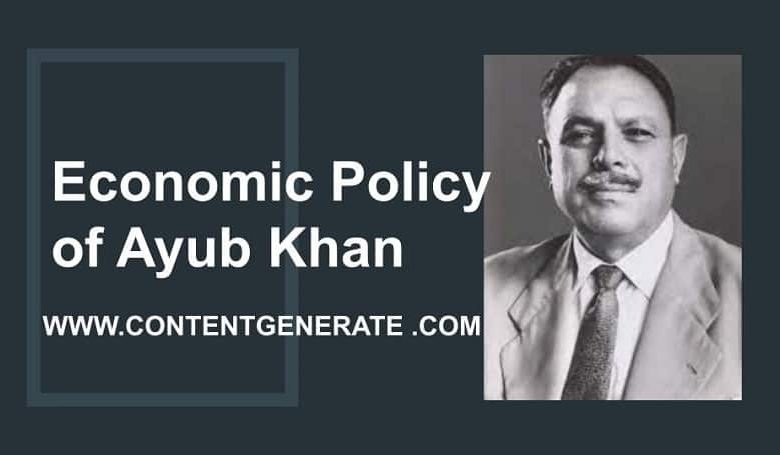Ayub Khan’s Economic Policy

This post discusses the main features of Ayub Khan’s economic policy that he introduced during his rule from 1958-1969.
Contents
What is an economic policy?
The term economic policy refers to a course of action adopted by the central government to improve the economy of a country. In other words, economic policy is a set of guidelines set out to influence or control activities for achieving economic stability.
The formulation, implementation, and administration of economic policy is a function of the central government. These functions include decisions, e.g. taxation and spending, money supply, redistribution of money from rich to poor, etc.
Main features of Ayub Khan’s economic policy
Important features of Ayub Khan’s economic policy are as follows:
1. Liberalization and privatization
2. Reforms in the agricultural sector
3. Reforms in the industrial sector
Liberalization and privatization
Ayub Khan introduced partial liberalization in import policy. He restricted the import of consumer goods which Pakistan itself manufactured. To encourage the private sector the military regime of Ayub Khan provided exemption in both industrial and agricultural technology.
Impact of liberalization and privatization
The liberalization and privatization policy of Ayub Khan led to an increase in the money supply in the country. The monetary expansion in the 1st economic plan (1955-60) amounted to almost Rs. 2 B which saw an increase by almost Rs.3 B in the second economic plan (1960-65).
Similarly, the policy resulted in the expansion of bank credit both in the public and private sectors. During the first plan, the bank credit amounted to Rs.1.62 B which was increased to Rs.4.77 B in the second economic plan.
Industrial policy
Under its industrial policy, Ayub Khan’s regime gave subsidies and tariff protection to industries. For example, import controls imposed in 1955 with reference to industry-related raw material and technology were removed.
Ayub Khan’s regime restricted certain categories of imports esp. consumer goods produced within the country. It also exempted tariff duties on the import of industrial machinery. Moreover, to encourage local manufacturers, the government gave cheap loans on easy terms of return.
Apart from the above provisions, the government also provided incentives to encourage the production of exports. These incentives included:
1. The Bonus Voucher Scheme
2. Tax rebates
3. Tax exemptions
4. increase in depreciation allowances.
Impact of Industrial policy
As a result of the industrial policy, economic growth saw a sharp increase. The average annual growth rate reached 7% percent in the 1960s. This growth rate made Pakistan the fastest growing economy in South Asia. Pakistan performed stood three times ahead of India in terms of economic growth during the 1960s. Thus the economy of Pakistan significantly improved owing to an unprecedented rapid rise in production.
Agricultural policy of Ayub Khan
Introduction of new laws as part of Ayub Khan’s reforms and economic policy are discussed as follows:
Land reforms and the elite farmer strategy in agriculture.
Ayub Khan’s military regime introduced elite farmer policy as bureaucrats, army officers and capitalists could buy the extra lands taken over by the government as part of land reforms.
Upgrading and improving irrigation system
Two big dams, i.e. Tarbela and Marghal were constructed along with a number of barrages and canals in the country.
Introduction of High Yielding Variety Seeds and fertilizers
Ayub Khan provided the High Yielding Variety of Seeds and fertilizers at a discounted rate to increase soil fertility and agricultural productivity.
Mechanization of Agriculture/factorization
In order to get more output, the technology was also introduced as ‘factorization’. It further made easier work for farmers. It saved time, money and proved efficient.
Easy credit
As part of the larger plan of giving incentives to the farmers, the Agricultural development bank of Pakistan gave a credit policy to farmers. For example, the government started the tube wells project under which farmers received loans to be returned on easy installment.
Impact of the agricultural policy
The construction of dams, barrages, and canals brought huge tracks of unirrigated land under irrigation resulting in rising in crop cultivation. Mechanization of farming, the introduction of High Yielding Variety (HYV) Seeds, Use of fertilizers, etc. coupled with a boosted irrigation system resulted in an unprecedented increase in efficiency, time-saving farming practice, and rise in agricultural productivity.
The increase in crop farming helped meet the food needs of an increasing population at that time. It is because of this increase in crop production that the time period 1958-1968 is called the Green Revolution.
Impact of Land reforms
Although some people benefited, the powerful landlords managed to hang on to most of their vast landholdings. The little land that landlords gave up was in reality poor in quality and unproductive. The tenants could not benefit from the policy giving the first right to buy the land as they did not have money. Those who could buy the land included bureaucrats, army officers, and businessmen who had money. This was an emergence of a new class that now had huge capital on one hand and as well agricultural land on the other hand.


